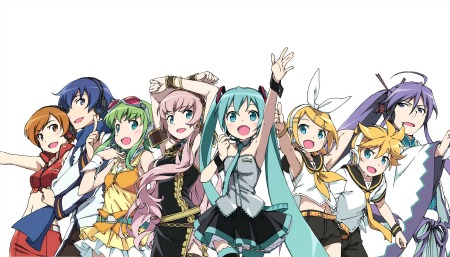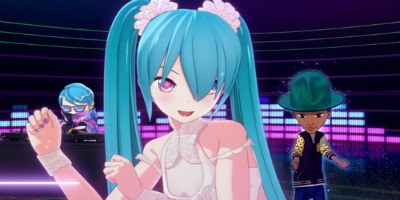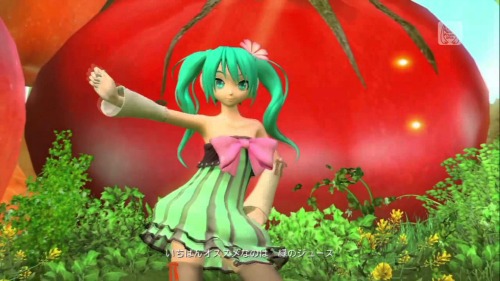Hatsune Miku: How a Virtual Idol Inspired Creativity
A singing sensation, Hatsune Miku has achieved more success than the average 16-year old girl. She’s collaborated with Pharrell, performed live on the David Letterman Show, opened for Lady Gaga, and has multiple endorsements from Yamaha, Sega, Domino’s Pizza and more. She has thousands of people buying tickets to see her concert and cosplaying as her in conventions. She’s become part of pop culture, well-known for her spring onion dance in “Levan Polkka”, which has become her signature item in fan art.
Her fan base has grown exponentially throughout the years, but what makes this turquoise-haired girl amazing is the fact that Hatsune Miku is not real – she’s a virtual robot developed by Crypton Future Media for the program, Vocaloid.

Vocaloid is a voice synthesizer program that enables users to create music using voice samples. After the user has programmed the lyrics and melody, the Vocaloid will sing and bring the song to life. Vocaloids have inspired many aspirational and professional music producers to generate music for the world. There are many Vocaloids similar to Hatsune Miku, such as Megurine Luka, Kaito, Kagamine Ren and Len, etc. However, Hatsune Miku remains the most popular in the market and became Japan’s first virtual idol.

Her rise to stardom has opened a flood of creativity, as she has inspired others to write over 100,000 songs for her. How does Hatsune Miku impact fans and boost their creativity? What does Hatsune Miku offer that draw people to her fan base?
Collaboration
Although Hatsune Miku is a virtual idol, she does not hire anybody to write her songs. Rather, it is the fans that produce and contribute music to her fan base. For example, the popularity of “Levan Polkka” inspired others to do more covers of songs with Hatsune Miku’s voice. It then evolved into original compositions, as Hatsune Miku transitioned into Japanese mainstream and interested J-Pop fans to use the Vocaloid software.
Hatsune Miku’s overwhelming popularity resulted in Crypton’s creation of Piapro.jp, a social media platform that allows Vocaloid enthusiasts to upload their creations. Nico Nico Douga (NND), a Japanese online video sharing service also became a popular, as NND was the first platform to host Vocaloid music. Furthermore, now that Hatsune Miku has joined the creative commons, fans are able to retain the rights to their music, giving them further incentive to create original works.

But what’s amazing about this virtual idol is not the fact that fans make her music, but that they collaborate and crowdsource to complete their projects. If a lyricist needs help on the instrumental, then they ask for assistance in the forums. Others participate by creating fan art or music videos once the song is complete. Everyone has something they can contribute, thus stimulating creativity because of the interactivity within Hatsune Miku’s fan base.
When a team strives to reach a goal together, it stimulates creativity, because there is communication and passion for their project. Even if that person is not working on a team, someone can upload their unfinished project onto a website and ask how to improve it. Listeners can contribute because they can share links to their favourite songs or discuss the meaning of the lyrics.
Compared to real-life artists, fans do not have to wait for Hatsune Miku’s single to be released – they can simply write their own or collaborate.
Expression
Along with collaboration, Hatsune Miku inspires creativity because there are no restrictions on what type of music can be produced. Hatsune Miku is capable of singing many genres, and her music ranges from ballads, to EDM, to pop, and more. Her high-pitched voice gives music producers an advantage, as she is capable of singing higher notes than most human singers. Of course, many fans prefer to write cute songs to match Hatsune Miku’s image, such as “Popipo”, which is a song about vegetable juice.

Hence, it is always interesting to see Hatsune Miku in a different perspective, as Satsuki Ga Tenkomori portrays Hatsune Miku as a party addict in their song, “Party Junkie”. As Vocaloids are avatars with no defined traits, listeners and producers can project whatever image they wish onto these characters. While many see Hatsune Miku as innocent, Tenkomori visualized Hatsune Miku as someone attracted to the ‘bad girl’ image. Although some fans disapprove of the explicit lyrics of alcohol and sex, this is Tenkomori’s interpretation of someone who’s engrossed in hedonistic culture, as the lyrics read:
Don’t you wanna be high? Just this is not enough
Just stay with me tonight
I don’t need a commitment – Party Junkie, English translated lyrics

There are those who portray Hatsune Miku with an even darker image, as Machigerita-P makes Hatsune Miku a yandere in their song, “Rotten Girl, Grotesque Love”. For those who do not know what a yandere is, it is a Japanese female archetype of a woman who is affectionate when she’s in love but gets violent when threatened. In this song’s situation, Hatsune Miku is a stalker who obsesses over a man dating another woman. As Machigerita-P specializes in the horror genre, this is one of their most popular Vocaloid songs, as a CreepyPasta was written to mislead fans to believe that this song was based on a true story.
Before we jump into the rabbit hole and dwell too much into the ‘dark personalities’ of Hatsune Miku, Machigerita-P’s depiction of Hatsune Miku is just another form of expression, as they did not use Miku’s ‘good girl’ image to limit their creativity. These examples demonstrate that through these interpretations, Hatsune Miku becomes more ‘realistic’ to her audience, as she transforms into a girl who not only has desires but also has different emotions to express.
Emotions
In the FineBros’ Youtube video, “Elders React to Vocaloids”, a lady asks the question: “How can anybody relate to a robot?”
It is because Hatsune Miku is a robot that artists use her to articulate emotions we’re afraid to recognize. For example, the song, “Irony”, depicts a girl who is lost in the world and wants to give up. In these lyrics, she feels helpless, and wishes to take a break from the world. However, time stops for nobody, so she must continue on despite her heavy heart.
I want to take a little break
I want to take a little break, but…
Time cruelly goes, hour by hour,
And so… drags me right along… – Irony, Translated English Lyrics
Another song that portrays sadness is “Fakery Tale”, which speaks about the death of a loved one and wishing that they would come back. In the music video, Hatsune Miku is sleeping, dreaming about the memories of her loved one. She wakes up to see the shadow of the man she’s been dreaming about, but he then disappears, leaving the fans to wonder if they were ever reunited. These songs portray such raw emotion, that they are capable of bringing listeners to tears – all because of a robot.

Although Hatsune Miku does not exist in real life, the fact that she is able to sing demonstrates that Hatsune Miku can embody emotions. Crypton even released an add-on called ‘Hatsune Miku Append’ that allows Miku to have different tones to her voice: soft, sweet, dark (mature and heartbroken), vivid, solid and light.
This package, combined with her dancing and music videos, helps bring the illusion that Hatsune Miku is real to her fans. It’s no wonder that Hatsune Miku is Japan’s most popular virtual idol, as her sweet image has blown up within Otaku culture for her anime looks and online video culture. However… that leads to the inevitable question: will robots eventually replace human singers?
“On the one hand you have musicians who think of her as a partner or platform for their own musical activities, on the other hand some creators consider her as a mere synthesizer.” – Hiroyuki Itoh, CEO of Crypton.
Although Hatsune Miku provides an opportunity for musicians to showcase their work, Vocaloids will not be able to replace human singers.
The benefit of virtual idols is that they are unable to sully their reputations, but what makes human singers easier to connect with is the fact that they’re… human. A musician’s history and actions affects the listeners, and either influences them to appreciate the artist or dislike them. However, Hatsune Miku has no struggling background. There is no information about her struggle to success or her life before becoming an idol. The only information that has been released is her height, weight and outfits. But to fans, that information is enough for them to love her.
Hatsune Miku is a computer-generated girl that was marketed to be the ‘first sound of the future’ (the literal translation of her name). But the impact she’s brought onto this world teaches us that humans are not the only ones capable of evoking emotions. It is because she’s a robot that Hatsune Miku should be recognized, as she is living proof that anyone (or anything) can affect others as long as the individual’s creativity is expressed.
Works Cited
“Machigerita-P.” Vocaloid Wiki. N.p., n.d. Web. 26 June 2015.
“Hatsune Miku / Vocaloid.” Know Your Meme News. N.p., n.d. Web. 26 June 2015.
Jenbae. “Can Robot Songs Make You Cry?” GoBoiano, 9 Mar. 2015. Web.
Rao, Mallika. “Meet Hatsune Miku, The Sensational Japanese Pop Star Who Doesn’t Really Exist.” The Huffington Post. N.p., 8 Oct. 2014. Web.
Rosenthal, Emerson. “Is Hatsune Miku The Perfect Pop Star?” The Creators Project. The Creators Project, 9 Oct. 2014. Web.
TheFineBros. “Elders React to Vocaloids!” Online video clip. Youtube, Apr. 18. 2013. Web.
Zoladz, Lindsay. “Hatsune Miku Is a Piece of Software. She May Also Be the Future of Music.” Vulture, 20 Nov. 2014. Web.
What do you think? Leave a comment.











Pretty soon she’ll accidentally release holographic nudes and break the internet!
One of the deeply annoying things about Miku is your child gets obsessed with her, and so you buy a Hatsune Miku costume, complete with awesome wig, which then you have to attempt (and fail miserably) to keep untangled.
Holograms have it easy.
Although a true human vocal performance is a lot different, this is a product of digital diversity coming together.
This pretty much just anime auto tunes with a twist. But this not something I can support.
I admit I have never listened to Miku before but her looks- it’s Pure Anime. Something tells me they’re going to make a musical Anime of her one day, if they haven’t already.
It seems anime isn’t needed to boost Vocaloids’ popularity, as they already are globally widespread.
Do you remember supercell’s Black Rock Shooter? They made an OVA, and eventually an anime TV series, out of it with an original story based on the song and its music video. It didn’t become a hit, however.
This was a really informative and great article! I had no idea who/what Hatsune Miku was until now. I repetitively saw images of her in fanart and thought it was part of an anime but my curiosity is fulfilled now that I know its origins, thanks!
I’m glad it was informative for you!
Fascinating. I have never heard of this and I think that it is really something interesting. I especially enjoyed the argument that she can evoke emotion and while I am not sure that I totally agree it is definitely something to be debated and looked at. Great work.
Although not everyone will agree with the arguments presented in this article, at least it evokes thought and discussion!
Thank you for commenting!
Mitsune can be anything, as long as she is stick-thin, wears mini-skirts and sings about being a princess.
That’s just her default outfit. She has hundreds of other designs(check the net). And she is not the only vocaloid. There are also male vocaloids who can become anything people wants to be. Just that Miku is the more popular one. Comes to show that women seem to have more influence than men. I don’t see any thing sexist about it. Fans just want to see/hear more Miku over Kaito and Gakupo.
I seem to remember, from my distant youth, an animated cartoon group called The Archies who had their own TV show and a number one single.
And even they were just channelling Pinky and Perky.
Bubble gum pop at it’s best/worst?
There’s no substitute for a real person, just ask all the teenyboppers who like One Direction at the moment.
This is an attempt to use a cartoon character to peddle pop tunes.
Only in Japan.
There is no limit on what genre Miku can sing. People have made her do pretty much everything, from opera to screamo.
This is brilliant. Not the music, but the possibilities of integrating audience and performer, and adapting and transforming the music. And it could spell the end of completely crap ‘manufactured’ music.
I agree completely. I think it’s really exciting (in a technological sense), and really only a step or two ahead of pop “stars” who’s songs and music is all written for them by others.
And they’ll never throw TV sets out of hotel windows, either.
Isn’t this just a expanded and updated version of Gorillaz? Of course Gorillas produced really good music too, unlike this. I have to say though, all J-pop whether made by holograms or (just about) real people is absolute tripe.
Well, Gorillaz didn’t allow users to compose their own music – Vocaloid’s a whole, new method of composition and expression. And, yes, there is the typical, crappy j-pop tunes, but there’s some excellent rock songs (Leia, The Lost One’s Weeping), dubstep (That Girl Doesn’t Scare Me), folk (The Spinning Song), techno dance (Spinal Fluid Explosion Girl).
The future of music in Japan.
Miku has been around for so long now.
wait until she downloads herself into a 3D printer and then walks away on her own steam…
One of the beautiful things about Miku (and there are many), is the sheer quantity and diversity of the music. People see a number like 100,000 songs, and it doesn’t really sink in. At 8 hours a day, it would take over four years to hear all of Miku’s songs. I’ve found over a thousand that I love, all from artists that I’d never have given a listen to just a couple of years ago. I simply can’t imagine my life without this music now, and every day brings new discoveries.
I agree; I found some artists I like all because of Vocaloid music. I think if people give it a chance, they’ll surely find a song that will appeal to them (because there’s so many to choose from).
The future of music? Or the death of it? You be the judge!
It will be two different market. Like lab diamond and natural diamond.
Kind of Interesting how, in reality, Hatsune Miku has become popular as simply an embodiment of people’s creative outlets but yet herself is just a figure. Perhaps Hatsune Miku is more of a social media outlet than anything, considering that things like Instagram twitter etc. let people do another variation of original media generation but all on the same platform.
I’ve followed the Hatsune Miku phenomena for a few years now and find the whole concept fascinating. People have used the software to produce some great music, from catchy pop to all manner of obscure sub genres.
Looking at Hatsume Miku and her success makes you wonder what’s the next step for the Vocaloid system. It sure will be interesting to see what they come up with next!
Miku isn’t a robot. Vocaloid is a voice synthesizer.
Yup! That’s why vocaloid is explained in the article.
OK n.n
I was just saying that because at the beginning it says “Virtual “robot”
I agree. Hatsune Miku is popular. She has even been seen on an american late night talk show. So she’s everywhere.
Eugh, i’ve watched a few videos of ‘her concerts’ and it makes my skin crawl a little.
It’s not for everyone, but at least you were open-minded to watch her videos 🙂
One of Miku’s main selling point is that she gives people who lack the ability to sing the ability to create songs. Nico NIco Douga, Japan’s famous video sharing site akin to Youtube, is filled with many original miku songs. The songs are not really only miku’s, but rather that of those who created the lyrics, the ones who composed the music, the members who tuned her voice (Sometimes they have fantastic tuners who can make her sound very close to a human’s), and the instrument players. There are also artists and editors who create music videos (MVs) for the song, combining many aspects of creativity together.
Every year on 3/9 (March 9th) it is miku’s day of saying thanks to all those who create songs with her. 39 in Japanese can be read as miku or sankyu. Hence this is the day dedicated to having a thank you celebration.
Though as you’ve said, miku will never be able to take over real singers. But Miku has allowed creativity to bloom for those without the luck of having a good voice. Sure you can get a human to sing for you, but this can create many problems such as time constraints. ryo of supercell once said that the songs he wrote had lyrics that were too embarrassing for real humans to sing. Hence he used miku. Eventually after gaining the ability to partner with human singers, he had to tone down some of his lyrics to less embarrassing lines. But his rise to success was paved by miku’s existence.
Man, I remember listening to Vocaloid songs back when I was a young teenager. I don’t think any other songs have ever made me cry.
Vocaloid, as you’ve said, is a very unique outlet for people who lack the voice. It can also lead into other things as well – for example, the anime Black Rock Shooter was based on a Vocaloid song of the same name, and Mekaku City Actors was based on a song series done by IA, another Vocaloid. It’s unfortunate that Vocaloids don’t have as strong a presence in the west; it’d be interesting to see what sort of influence a Vocaloid could have on the music industry.
You also should have mentioned Project Diva the video game 🙂
she is not an “virtual robot” she is an “virtual girl”
am example of a virtual robot would be: oriana (from league of legends)
an example of a virtual girl (quoting the same game) would be lux, she is an virtual “Human” not an virtual machine.
in the case of hatsune, she can be portrayed as an robot if the creator wishs but as defautl she is human.
beside that the article is accurate. (AFAIK)
This seems to have been a muse for future idols and V-Tubers.